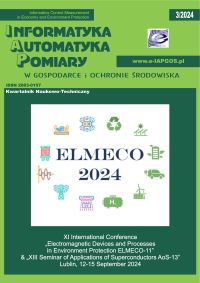SZYFRY BLOKOWE NA PODSTAWIE ODWRACALNYCH AUTOMATÓW KOMÓRKOWYCH
Yuliya Tanasyuk
y.tanasyuk@chnu.edu.uaYuriy Fedkovych Chernivtsi National University (Ukraina)
http://orcid.org/0000-0001-8650-0521
Petro Burdeinyi
Yuriy Fedkovych Chernivtsi National University, Department of Computer Systems and Networks (Ukraina)
http://orcid.org/0000-0002-3859-7522
Abstrakt
The given paper is devoted to the software development of block cipher based on reversible one-dimensional cellular automata and the study of its statistical properties. The software implementation of the proposed encryption algorithm is performed in C# programming language in Visual Studio 2017. The paper presents specially designed approach for key generation. To ensure desired cryptographic stability, the shared secret parameters can be adjusted to contain information needed for creating substitution tables, defining reversible rules, and hiding final data. For the first time, it is suggested to create substitution tables based on iterations of a cellular automaton that is initialized by the key data.
Słowa kluczowe:
szyfr bloku, algorytm szyfrowania symetrycznego, odwracalny automat komórkowyBibliografia
Bouchkaren S., Lazaar S.: A fast cryptosystem using reversible cellular automata. International Journal of Advanced Computer Science and Applications 5(5)/2014, 207–210.
DOI: https://doi.org/10.14569/IJACSA.2014.050531
Google Scholar
Debasis D., Abhishek R.: A parallel encryption algorithm for block ciphers based on programmable reversible cellular automata. J. Computer Science and Engineering 1(1)/2010, 82–90.
Google Scholar
Gutowitz H.A.: Cryptography with Dynamical Systems: Cellular Automata and Cooperative Phenomena. Kluwer Academic Press, Dordrecht 1993.
DOI: https://doi.org/10.1007/978-94-011-1691-6_21
Google Scholar
Paar C., Peltz J.: Understanding cryptography. Springer-Verlag, Berlin Heidelberg 2010.
DOI: https://doi.org/10.1007/978-3-642-04101-3
Google Scholar
Leporati A., Mariot L.: Cryptographic properties of bipermutive cellular automata rules. J. Cellular Automata 9/2014, 437–475.
Google Scholar
Seredynski M., Bouvry P.: Block cipher based on cellular automata. New Generation computing 23(3)/2005, 245–258.
DOI: https://doi.org/10.1007/BF03037658
Google Scholar
Seredynski F., Bouvry P., Zomaya A. Y.: Cellular automata and secret key cryptography. Parallel Computing 30(5-6)/2004, 753–766, [DOI:10.1016/j.parco.2003.12.014].
DOI: https://doi.org/10.1016/j.parco.2003.12.014
Google Scholar
Tomassini M., Perrenoud M.: Stream Cyphers with One- and Two-Dimensional Cellular Automata. Parallel Problem Solving from Nature PPSN VI. PPSN. Lecture Notes in Computer Science vol. 1917. Springer, Berlin, Heidelberg, 2000, 722–731.
Google Scholar
Wolfram S.: Cryptography with Cellular Automata.: Advances in Cryptology: Crypto’85, Springer-Verlag LNCS 218, 1985, 429–432.
DOI: https://doi.org/10.1007/3-540-39799-X_32
Google Scholar
NIST SP 800-22: Documentation and Software. Random bit generation. - Guide to the statistical tests, https://csrc.nist.gov/Projects/Random-Bit-Generation/Documentation-and-Software/Guide-to-the-Statistical-Tests
Google Scholar
Wolfram S.: A New Kind of Science.: Wolfram Media, Inc, 2002, 1197, http://www.wolframscience.com/nksonline/toc.html
Google Scholar
Autorzy
Yuliya Tanasyuky.tanasyuk@chnu.edu.ua
Yuriy Fedkovych Chernivtsi National University Ukraina
http://orcid.org/0000-0001-8650-0521
Autorzy
Petro BurdeinyiYuriy Fedkovych Chernivtsi National University, Department of Computer Systems and Networks Ukraina
http://orcid.org/0000-0002-3859-7522
Statystyki
Abstract views: 347PDF downloads: 195
Licencja

Utwór dostępny jest na licencji Creative Commons Uznanie autorstwa – Na tych samych warunkach 4.0 Miedzynarodowe.
Inne teksty tego samego autora
- Yuliya Tanasyuk, Sergey Ostapov, OPRACOWANIE I BADANIA KRYPTOGRAFICZNYCH FUNKCJI SKRÓTU (HASH) NA PODSTAWIE DWUWYMIAROWYCH AUTOMATÓW KOMÓRKOWYCH , Informatyka, Automatyka, Pomiary w Gospodarce i Ochronie Środowiska: Tom 8 Nr 1 (2018)








